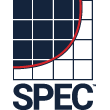|
New SPECviewperf 7.0 Benchmark
Traces Real-World Application Performance
Adds three new viewsets for
popular graphics applications
WARRENTON, Va., May 6, 2002 - SPEC/GPC's OpenGL Performance
Characterization (SPECopc) project group today released SPECviewperf
7.0, a major new version of its application-based performance evaluation
software. The new benchmark is available for free downloading on this
web site. Initial SPECviewperf 7.0 test results from SPECopc members
will be available on the site May 15.
SPECviewperf 7.0 includes new features for more accurately capturing
graphics functionality from real applications. It provides new and updated
viewsets representing popular CAD/CAM/CAE and digital content creation
(DCC) applications.
SPECviewperf 7.0 enables general state changes to be made during frames,
bringing the benchmark much closer to how applications behave in the
real world. Data traversal, facet color processing, and display of lighting
and textures can now be changed from frame to frame.
The new viewsets have been designed to take advantage of the added
capabilities within SPECviewperf 7.0. The viewsets' frames are based
on traces of graphics commands made while running the actual applications.
As a result, vendors and users can tune their graphics subsystems to
the viewsets and see performance improvements in the actual applications.
Three new viewsets have been added based on traces of SPEC/GPC's Application
Performance Characterization Group (SPECapc) benchmarks:
- 3dsmax-01, based on SPECapc for 3ds max 3.1 configured with
the Open GL driver, includes three models containing an average of
1.5 million vertices each, and tests performance of scenes with different
levels of lighting.
- proe-01, based on SPECapc for Pro/ENGINEER™ 2000i²,
measures two models in three modes - shaded, wireframe and hidden-line
removal (HLR).
- ugs-01, based on SPECapc for Unigraphics V17, tests performance
based on an engine model containing 2.1 million vertices.
The new viewsets replace three viewsets from SPECviewperf 6.1.2 that
were deemed obsolete: awadvs-04 was retired because frame rates
commonly exceeded refresh rates and it was based on an application that
no longer exists; medmcad-01 represented a mix of CAD/CAM functionality
and didn't focus on a specific application; and procdrs-03 was
replaced because frame rates commonly exceeded refresh rates and the
test no longer reflected the real application.
Three long-time viewsets have been updated to run under SPECviewperf
7.0: dx-07, based on the Data Explorer (DX) visualization application;
drv-08, based on the DesignReview model review application; and
light-05, based on the Lightscape radiosity visualization application.
As a result of the major revisions and new viewsets, results reported
under SPECviewperf 7.0 cannot be compared with previously reported SPECviewperf
results.
"The release of SPECviewperf 7.0 is significant because it brings
graphics performance measurement much closer to what everyday users
experience with their applications in the real world," says Bill
Licea-Kane of ATI, SPECopc's chair. "The new tracing functionality
will allow us to quickly add and update application-based viewsets to
better meet users' needs."
SPECviewperf measures the 3D rendering performance of systems running
under the OpenGL application programming interface (API). Viewsets are
the test files that run under SPECviewperf. They represent a similar
mix of graphics rendering and manipulation found in actual applications.
SPECopc is a project group of the Graphics Performance Characterization
(GPC) Group, which in turn is part of the Standard Performance Evaluation
Corp. (SPEC). SPEC is a non-profit corporation formed to establish,
maintain and endorse a standardized set of relevant benchmarks that
can be applied to the newest generation of high-performance computers.
SPEC's membership includes computer hardware and software vendors, and
leading universities and research facilities worldwide.
###
Press contacts:
Bob Cramblitt, Erin Hatfield
Cramblitt & Company
919-481-4599
[email protected]
|




